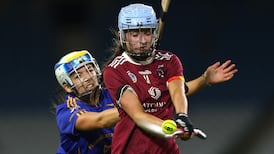And we’re off. This weekend sees the flag go up on the race for Sam Maguire in a football season with an unprecedentedly intense fixtures’ list. There has been a lot of fair commentary on the lack of jeopardy in the competition but that’s not the limit of the concerns about the coming weeks.
There are simply too many teams for competitive impact, regardless of jeopardy. Even were every fixture to count for something there would be inevitable mismatches and heavy defeats.
Looking at the now complete groups there isn’t a great deal of speculation about outcomes, which by the nature of things is more to do with who loses out rather than who progresses, but a couple of matches, like Louth-Cork and Clare-Donegal, will sort that out.
What, therefore, are we being asked to watch? This coming weekend has two of the round-robin’s most box-office pairings, Kerry v Mayo and Galway v Tyrone, but aside from the advantages of coming first in the group the matches won’t fatally undermine anyone.
READ MORE
They will have a league-ish appeal. Mayo supporters won’t have seen their team in six weeks, a long time at this stage of the year, and will be anxious to see how they recovered after the unexpected defeat by Roscommon, but there’ll be no knots of tension in the pit of anyone’s stomach.
This lack of competitive traction has been well publicised and it is an extension of the GAA’s problem with a thinning field of contenders. Whereas football is super-competitive at the top end – All-Ireland semi-finals plus one or two – the path that leads to that elevation is not strewn with barriers and pitfalls.
It is easy to see the appeal of lots of round-robin matches, bestowing home fixtures on counties and creating the same starting point for all 16 teams, but how many of these matches will be genuinely competitive?
Round-robin is a volatile format for Gaelic games. In the past – the hurling qualifier arrangement from 2005 to 2007 – it depressed the crowds, probably in all senses, because the two teams to progress was so obvious each year.
The All-Ireland football quarter-final structure, the Super 8s, introduced in 2018, held up better with issues surviving to the last day in both years before Covid unplugged it in the two championships that followed. But there were still beatings and inequalities.
These couldn’t all be laid at the door of the format, which after all was just a different way of playing off the last eight counties in the quarter-finals. By the time the Super 8s arrived, the quarter-finals were already beginning to creak as competitive engagements.
It’s hard to imagine what an innovation the quarter-finals were when introduced in 2001. Straight knockout matches between a variety of counties in pairings that were often unusual. As it happened in the first year three of the matches were reruns of provincial championship fixtures but this was alleviated by the first Kerry-Dublin encounter in the All-Ireland series for 16 years.
It even went to a replay. During the next six years there were seven replays in the quarter-finals and the average winning margin was just 0-4. From then up until the format change in 2017 there was just one further replay (as well as one quarter-final that went to extra-time, as was the rule that year, 2011).
Average winning margins almost doubled during that time and the two least competitive years – winning margins averaging nearly 0-12 – occurred in the last three championships, 2015 and 2017, before the Super 8s were introduced the following year. That stabilised things a little but during the two years more than a quarter of the matches ended in double-digit whackings.
Last year the quarter-finals returned but the margins were still averaging more than 0-8 and that included the Galway-Armagh tie that went to penalties. Without it the other three averaged 0-11.
So the last eight contenders for Sam Maguire were producing matches that were generally uncompetitive. This year the big chance being taken is that the round-robin field is being doubled from eight to 16.
If there was an abiding anxiety about this within the GAA it was concerning dead rubbers – matches that would mean nothing in the greater scheme of things and on all known evidence discourage crowds from attending.
In the desire to ensure that every team would have something to play for, for as long as possible, the GAA paradoxically ensured that there would be little to play for in terms of survival – only four counties depart at the end of the group stages. The reassurance that teams would have meaningful matches until the end was based on smaller-scale considerations.
It makes sense for a county to win its group because it gets one match fewer and a week off and the second-placed team will have home advantage in the preliminary quarter-finals but no one’s neck is exposed to the blade.
There is an argument that GAA championships are not simply about competition but also a sort of national sporting festival in which everyone wants to participate regardless of chances of winning. That cheery concept has been undermined by the rationalisation implicit in the Tailteann Cup for Tier 2 counties.
If the Sam Maguire is viewed as simply a prioritising competition the continued hard-wiring of the provincial championships into the All-Ireland makes little sense. If, however, the concept of getting a shot at the big time is still important the current system is an ingenious way of offering a glimpse of motivation to counties outside the top half of the league.
Where it takes them isn’t immediately obvious and the suspicion remains that there are too many teams in the round-robin series.
e: sean.moran@irishtimes.com
















